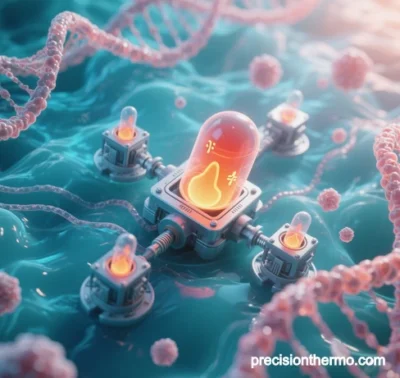
PrecisionThermo: Applications and Critical Roles in Biomedicine
Precision thermal control technology (PrecisionThermo), achieving sub-degree or even millidegree temperature accuracy, has become a cornerstone in biomedical research and clinical practice. Its core value lies in preserving biological activity, optimizing reaction efficiency, and mitigating thermal damage risks. Below is an in-depth analysis of its applications and technical significance.
I. Applications
- Cell and Biospecimen Preservation
- Cell Therapy & Regenerative Medicine:
PrecisionThermo ensures viability of CAR-T cells and stem cells through ultra-low temperature storage and programmed resuscitation. Advanced incubators maintain metabolic stability during culture by minimizing temperature fluctuations. - Biobanking:
Millidegree-accurate systems enable vitrification cryopreservation of embryos, oocytes, and viral stocks, preventing ice crystal formation and cellular damage.
- Cell Therapy & Regenerative Medicine:
- Drug Development & Manufacturing
- Biopharmaceutical Processes:
Temperature control in bioreactors (±0.5°C) governs protein folding and antibody/vaccine yield. PID-regulated systems ensure batch consistency in large-scale production. - Lyophilization:
Precision drying avoids thermal degradation of active ingredients while achieving ultra-low moisture content.
- Biopharmaceutical Processes:
- Clinical Diagnosis & Therapy
- Hyperthermia Oncology:
Whole-body heating systems induce tumor-specific heat shock protein expression, enhancing radiotherapy efficacy. Core temperature stability (±0.1°C) is critical for safety and outcomes. - Surgical Environment Control:
Real-time patient temperature regulation prevents hypothermia-induced complications, reducing postoperative infection risks.
- Hyperthermia Oncology:
- Medical Devices
- In Vitro Diagnostics (IVD):
Rapid thermal cycling in PCR systems ensures DNA amplification specificity, while Peltier-based modules maintain uniformity for accurate results. - Advanced Imaging:
Localized temperature control in super-resolution microscopy minimizes thermal drift, enabling nanometer-scale pathogen visualization.
- In Vitro Diagnostics (IVD):
II. Technical Significance
- Biological Activity Preservation
- Enzymes and proteins lose functionality with minor temperature deviations. PCR workflows, for instance, demand strict thermal thresholds to preserve polymerase activity.
- Stem cell differentiation pathways are temperature-sensitive, requiring millidegree precision to guide lineage-specific outcomes.
- Reproducibility in Research & Therapy
- Standardized temperature-humidity cycles in stability testing ensure consistent drug degradation profiles across batches.
- Closed-loop feedback systems in hyperthermia adjust parameters dynamically to maintain therapeutic consistency.
- Energy-Safety Balance
- Peltier-based systems eliminate refrigerant leaks while reducing energy consumption.
- Biodegradable thermal patches degrade post-use, avoiding secondary surgeries and inflammatory responses.
- Interdisciplinary Integration
- AI-driven algorithms optimize temperature curves using real-time bioreactor data (e.g., oxygen levels, pH).
- Microfluidic systems with nanoscale thermal control enable single-cell metabolic analysis.
III. Industry Impact & Future Trends
- Cell Therapy Commercialization:
Cost-effective cryopreservation drives scalable personalized therapies. - Precision Hyperthermia Adoption:
Compact, intelligent systems democratize access to thermal oncology treatments. - Lab Automation:
Integration with robotic platforms enables uninterrupted, error-free cell culture workflows.
Conclusion
PrecisionThermo’s millidegree accuracy and dynamic responsiveness make it indispensable for biomedical advancements, from cell-based therapies to drug manufacturing. As quantum sensing and AI converge, this technology will redefine limits in gene editing, organ-on-chip systems, and beyond, cementing its role as a foundational tool for next-generation biotech innovation.
Data sourced from public references. For collaboration or domain inquiries, contact: chuanchuan810@gmail.com





